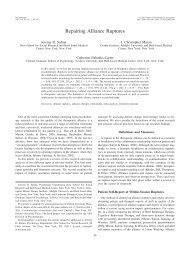Download - The Safran Lab
Download - The Safran Lab
Download - The Safran Lab
You also want an ePaper? Increase the reach of your titles
YUMPU automatically turns print PDFs into web optimized ePapers that Google loves.
COGNITIVE-BEHAVIORAL THERAPY<br />
25. Probes for client's beliefs or personal meaning behind client's thoughts. "What<br />
does that mean to you?," "What does that thought mean to you?," "If you think that he<br />
doesn't want to talk to you, what does that mean to you?," "It sounds like you believe that<br />
in order to feel good about yourself, you must be liked by everybody."<br />
26. Helps client identify cognitive distortions, errors that were present in his/her<br />
thinking. Magnifying, maximizing, catastrophizing, personalizing, generalizing. "Do<br />
you see how this all-or-none thinking actually decreases your options?," "It sounds like<br />
you believe that the only possible result of your effort is going to be failure. Is there a<br />
more accurate way of looking at this problem? Do you see how you are singling out the<br />
worst possible case scenario?"<br />
27. Engages in didactic persuasion. <strong>The</strong> stance is teaching, guiding, persuading. It is a<br />
goal-directed stance that is meant to, through examining evidence, convince the client<br />
that his/her way of thinking is erroneous. "This plan we were talking about allowed you<br />
to test out the predictions you had. Do you see how you were able to disprove those<br />
predictions and thus get more accurate information?"<br />
28. Asks client to report specific thoughts. Asks client to report specific thoughts as<br />
verbatim as possible. In order to code this item, it must be specific and verbatim. "What<br />
specific thoughts do you have about that?," "Let's get to the thought that you're having<br />
about this feeling."<br />
29. Encourages client to distance him/herself from his/her thoughts, viewing them<br />
as beliefs rather than facts. <strong>The</strong>rapist urges or challenges the client to consider the<br />
thoughts as beliefs which may or may not be true. <strong>The</strong>rapist urges the client to consider<br />
his/her thoughts as testable hypotheses rather than given facts. "What's that thought<br />
about?," "What is that thought?," NOT "What do you think?" or "What do you believe?"<br />
30. Helps client examine currently available evidence or information to test the<br />
validity and realistic consequences of the client's beliefs. <strong>The</strong>rapist helps the client use<br />
evidence from 1) client's past experience, 2) his/her knowledge of the way the world<br />
works, to test his/her beliefs for validity. This can also be applied when the therapist<br />
looks at the realistic consequences of an event with the client. "Let's look at what actually<br />
happened and see if your belief still holds," "What's the evidence for the belief that your<br />
friends can't stand you?"<br />
31. Facilitates client's consideration of alternative explanations for events. Did the<br />
therapist help the client consider alternative explanations for events besides the client's<br />
initial explanation? "What would be another way to explain why Bill reacted in this<br />
way?," "What about considering another perspective on the situation?," "Are there other<br />
factors which could have played a role in your not getting the position?"<br />
100



